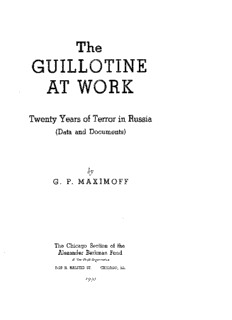
The Guillotine at Work, Vol. R_ - Alexander Berkman Fund version PDF
Preview The Guillotine at Work, Vol. R_ - Alexander Berkman Fund version
The GUILLOTINE AT WORK Twenty Years of Terror in Russia (Data and Documents) by G. P. MAXIMOFF The Chicago Section of the Alexander Berkman Fund A Non-Profit Organisation 2422 N. HALSTED ST. CHICflGO, ILL. IP40 Translated from Russian Copyright 1940 by G. P. MaximoFf Printed in the United States of America All rights reserved. No part of this book may be reproduced in any form without the permission of the Chicago' Section of the Alexander Berkman Fund. GLOBUS PRINTING COKPOKATION 1939-41 West North Avenue Chicago, Illinois <<^^^S66 Publisher s Preface The March revolution subverted the power of the Romanovs and settled accounts with the Tzarist regime. In one day mon archist Russia became transformed into the freest country in the world. The Tzar's prisoners were immediately released from the prisons and penal servitude, and brought back from places of exile. The prisons became deserted. No one thought they would soon be filled again with politicals. The various societies to aid the political prisoners and exiles, the so-called Red and Black Crosses, were dissolved in Russia itself as well as abroad where political emigrants held it a duty to organize material and moral aid to their more unfortunate comrades and brothers languishing in the Tzar's numerous torture chambers. However, those sanguine hopes were soon brought to an end. They faded before they had come to flower. The October upheaval brought Russia to a one-party dictatorship, the dicta torship of the Bolshevik party, which unwarrantedly called it self "the dictatorship of the proletariat". In the name of the dictatorship of the proletariat and under the pretense of its in terests, this party unloosed a campaign of terror against any op position. The bourgeois parties were outlawed; the socialist parties—the Social-Democrats and the Social-Revolutionists— were dubbed "entente agents" and "tuft hunters of the counter revolution." The next logical step was to hound those parties, to suppress their papers, to arrest and expel their members from the Soviets. As the civil war swept on, all non-Bolshevik elements were dubbed "petty-bourgeois and counter-revolution ary elements". Right and Left Social-Revolutionists, Social- Democrat of all shades. Maximalists, Anarchists of every ten dency—all were placed in the same category of "counter-revolu tionists". A campaign of slandering and baiting was launched against such "counter-revolutionists".
Description: